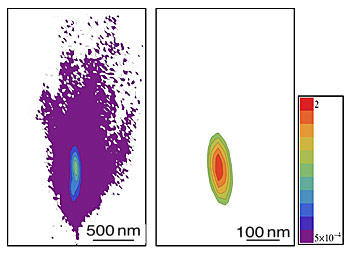
NIST researchers' new approach to trapping nanoparticles uses a control and feedback system that nudges them only when needed, lowering the average intensity of the beam and increasing the lifetime of the nanoparticles while reducing their tendency to wander. On the left, 100-nanometer gold nanoparticles quickly escape from a static trap while gold nanoparticles trapped using the NIST method remained strongly confined.
Using a refined technique for trapping and manipulating nanoparticles, researchers at the National Institute of Standards and Technology (NIST) have extended the trapped particles' useful life more than tenfold. This new approach, which one researcher likens to "attracting moths," promises to give experimenters the trapping time they need to build nanoscale structures and may open the way to working with nanoparticles inside biological cells without damaging the cells with intense laser light.
Scientists routinely trap and move nanoparticles in a solution with "optical tweezers"—a laser focused to a very small point. The tiny dot of laser light creates a strong electric field, or potential well, that attracts particles to the center of the beam. Although the particles are attracted into the field, the molecules of the fluid they are suspended in tend to push them out of the well. This effect only gets worse as particle size decreases because the laser's influence over a particle's movement gets weaker as the particle gets smaller. One can always turn up the power of the laser to generate a stronger electric field, but doing that can fry the nanoparticles too quickly to do anything meaningful with them—if it can hold them at all.
NIST researchers' new approach uses a control and feedback system that nudges the nanoparticle only when needed, lowering the average intensity of the beam and increasing the lifetime of the nanoparticle while reducing its tendency to wander. According to Thomas LeBrun, they do this by turning off the laser when the nanoparticle reaches the center and by constantly tracking the particle and moving the tweezers as the particle moves.
"You can think of it like attracting moths in the dark with a flashlight," says LeBrun. "A moth is naturally attracted to the flashlight beam and will follow it even as the moth flutters around apparently at random. We follow the fluttering particle with our flashlight beam as the particle is pushed around by the neighboring molecules in the fluid. We make the light brighter when it gets too far off course, and we turn the light off when it is where we want it to be. This lets us maximize the time that the nanoparticle is under our control while minimizing the time that the beam is on, increasing the particle's lifetime in the trap."
Using this method at constant average beam power, 100-nanometer gold particles remained trapped 26 times longer than had been seen in previous experiments. Silica particles 350 nanometers in diameter lasted 22 times longer, but with the average beam power reduced by 33 percent. LeBrun says that their approach should be able to be combined with other techniques to trap and hold even smaller nanoparticles for extended periods without damaging them.
"We're more than an order of magnitude ahead of where we were before," says LeBrun. "We now hope to begin building complex nanoscale devices and testing nanoparticles as sensors and drugs in living cells.
A. Balijepalli, J. Gorman, S. Gupta and T. LeBrun. Significantly Improved Trapping Lifetime of Nanoparticles in an Optical Trap using Feedback Control. Nano Letters. April 10, 2012. Available online doi/acs/10.1021/nl300301x.

